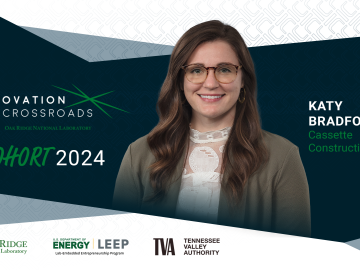
Filter News
Area of Research
News Topics
- (-) Climate Change (26)
- (-) Neutron Science (16)
- (-) Partnerships (19)
- 3-D Printing/Advanced Manufacturing (19)
- Advanced Reactors (3)
- Artificial Intelligence (32)
- Big Data (16)
- Bioenergy (11)
- Biology (14)
- Biomedical (8)
- Biotechnology (7)
- Buildings (23)
- Chemical Sciences (22)
- Clean Water (5)
- Composites (8)
- Computer Science (29)
- Critical Materials (7)
- Decarbonization (26)
- Education (2)
- Emergency (1)
- Energy Storage (12)
- Environment (25)
- Exascale Computing (10)
- Fossil Energy (3)
- Frontier (9)
- Fusion (9)
- Grid (10)
- High-Performance Computing (22)
- Isotopes (15)
- ITER (1)
- Machine Learning (12)
- Materials (17)
- Materials Science (20)
- Mathematics (5)
- Microelectronics (2)
- Microscopy (2)
- Molten Salt (1)
- Nanotechnology (2)
- National Security (26)
- Net Zero (6)
- Nuclear Energy (12)
- Physics (7)
- Polymers (5)
- Quantum Computing (13)
- Quantum Science (15)
- Security (3)
- Simulation (17)
- Space Exploration (3)
- Statistics (2)
- Summit (6)
- Sustainable Energy (21)
- Transportation (14)
Media Contacts

Daryl Yang is coupling his science and engineering expertise to devise new ways to measure significant changes going on in the Arctic, a region that’s warming nearly four times faster than other parts of the planet. The remote sensing technologies and modeling tools he develops and leverages for the Next-Generation Ecosystem Experiments in the Arctic project, or NGEE Arctic, help improve models of the ecosystem to better inform decision-making as the landscape changes.

ORNL’s Matthew Loyd will receive a Department of Energy Office of Science Early Career Research award.

Katy Bradford is on a mission to revolutionize the construction industry and is the founder of Cassette Construction, a company in the newest cohort of Innovation Crossroads, a DOE Lab-Embedded Entrepreneurship Program node at ORNL. As an Innovation Crossroads fellow, Bradford and her company will receive technical, financial and networking support to successfully advance the company’s products to the marketplace.

Scientists using high-resolution aerial scans and computational modeling concluded that wildfires, storms and selective logging have become key drivers behind rainforest carbon emissions, outpacing clear-cutting practices.

The "SNS LEGO Model Middle School Outreach Program" invites middle school students to build a LEGO model of the SNS, a major scientific accelerator. This engaging initiative aims to teach students about STEM careers and the inner workings of the SNS through hands-on construction and interactive lessons. Launching next spring, the program seeks to inspire interest in science and engineering among young learners.

A group of scientists at the Department of Energy’s Oak Ridge National Laboratory have conducted neutron scattering research to reveal key information about fungus cell membranes that could aid in developing new antifungal treatments.

As a mechanical engineer in building envelope materials research at ORNL, Bryan Maldonado sees opportunities to apply his scientific expertise virtually everywhere he goes, from coast to coast. As an expert in understanding how complex systems operate, he’s using machine learning methods to control the process and ultimately optimize performance.

ORNL’s Joshua New was named the 2024 Researcher of the Year by R&D World magazine as part of its R&D 100 Professional Award winners.

DOE commissioned a neutron imaging instrument, VENUS, at the Spallation Neutron Source in July. VENUS instrument scientists will use AI to deliver 3D models to researchers in half the time it typically takes.

A study found that beaches with manmade fortifications recover more slowly from hurricanes than natural beaches, losing more sand and vegetation. The researchers used satellite images and light detection and ranging data, or LIDAR, to measure elevation changes and vegetation coverage. Changes in elevation showed how much sand was depleted during the storm and how much sand returned throughout the following year.


